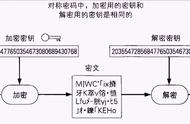密码学系列 - 对称加密
本文讨论的对称加密算法主要包括 des、3DES、AES
DES
明文:64 bit 密文:64 bit 密钥:56/64 bit(每 7 位插入一个校验位的时候为 64 bit) 其设计思想充分体现了香农提出的混淆和扩散原则

DES 使用的是 Feistel 结构来加密的,一共需要 16 轮,加密过程如下:
- 将明文进行初始置换(通过置换表)
- 将置换后的数据分为左右 L1 R1 各 32 bit
- 将 48 bit 的子密钥与 R1 作为轮函数F的输入
- 将 L1 与轮函数的输出异或运算,得到 L1密文
- 将 L1 密文与 R1 交换位置,分别作为下一轮的 R2,L2
- 将 2-5 再重复 15 次
- 将 L17 R17 交换位置,并拼接为 64bit 数据
- 将 64bit 数据进行逆初始置换,得到最终密文
需要注意的是:
- 子密钥在每一轮中都是不一样的
- 每一轮之间会将左侧和右侧对调(右侧没有加密)
- 解密的过程就是将输出用相同的子密钥再走一遍,如果加密的子密钥顺序是key1 key2 key3,则解密的子密钥为key3 key2 key1
- 轮函数可以设计为不可逆函数如hash,对解密没有影响

golang 代码实战:
func TestDesEncrypt(t *testing.T) { key:=[]byte{0x01,0x01,0x01,0x01,0x01,0x01,0x01,0x01} cipherBlock,err:=des.NewCipher(key) if err!=nil{ t.Error(err) } src:=[]byte{0x01,0x02,0x03,0x04,0x05,0x06,0x07,0x08} encrptDst :=make([]byte,len(src)) cipherBlock.Encrypt(encrptDst,src) t.Log(encrptDst) plainDst:=make([]byte,len(encrptDst)) cipherBlock.Decrypt(plainDst, encrptDst) t.Log(plainDst) } //out: [206 173 55 61 184 14 171 248] //out: [1 2 3 4 5 6 7 8]
三重DES
明文:64 bit 密文:64 bit 密钥:56/64 * 3 bit(加入校验位的时候为64 bit)
为了增加 DES 的强度,明文经过 3 次 DES 处理后变成最后的密文,因此密钥长度为 56/64 * 3 bit。3 次 DES 处理并不是简单的 3 次加密的过程,而是加密、解密、加密,解密的过程相应的就是解密、解密、解密。这样设计是因为在 3 个密钥相同时,可以兼容 DES 算法

golang 代码实战:
func TestTripleDesEncrypt(t *testing.T) { key:=[]byte{0x01,0x01,0x01,0x01,0x01,0x01,0x01,0x01,0x01,0x01,0x01,0x01,0x01,0x01, 0x01,0x01,0x01,0x01,0x01,0x01,0x01,0x01,0x01,0x01} cipherBlock,err:=des.NewTripleDESCipher(key) if err!=nil{ t.Error(err) } src:=[]byte{0x01,0x02,0x03,0x04,0x05,0x06,0x07,0x08} encrptDst :=make([]byte,len(src)) cipherBlock.Encrypt(encrptDst,src) t.Log(encrptDst) plainDst:=make([]byte,len(encrptDst)) cipherBlock.Decrypt(plainDst, encrptDst) t.Log(plainDst) } //此处3个密钥相同,兼容DES //out: [206 173 55 61 184 14 171 248] //out: [1 2 3 4 5 6 7 8]
AES
明文:128 bit 密文:128 bit 密钥:128/192/256 bit (分别需要10/12/14轮)
AES 标准最后评选出的算法是 Rijindale 算法,该算法支持密钥 128/192/256 bit ,分别需要 10/12/14 轮,本文讨论的是 128 bit密钥。它的加密过程并没有使用 DES 的 feistel 结构,而是使用了一种新的 SPN 结构,需要 10-14 轮计算,如下图:


























